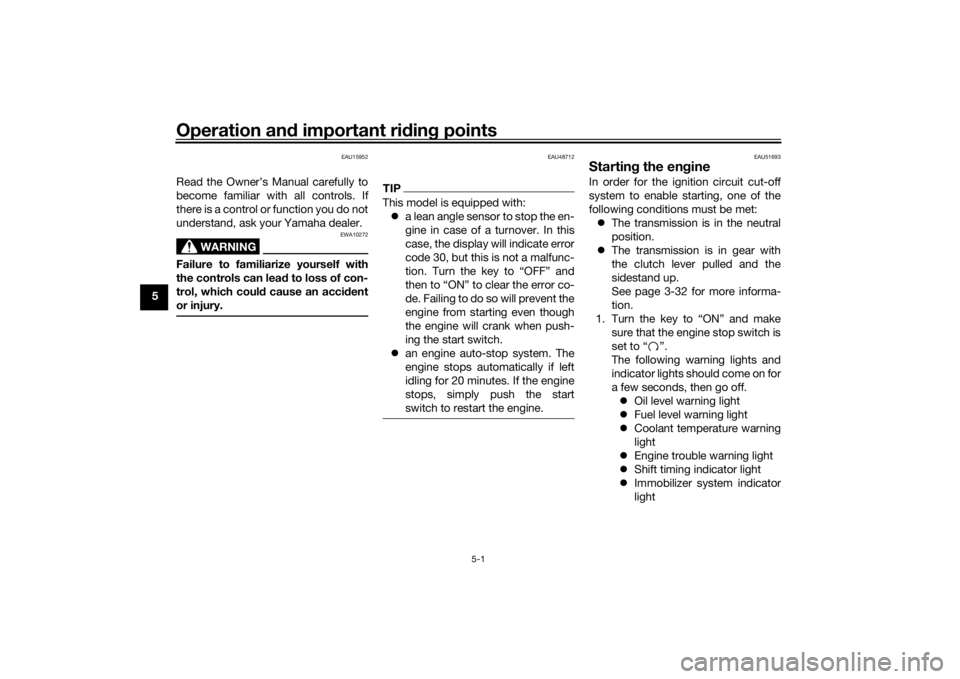warning light YAMAHA VMAX 2016 User Guide
[x] Cancel search | Manufacturer: YAMAHA, Model Year: 2016, Model line: VMAX, Model: YAMAHA VMAX 2016Pages: 112, PDF Size: 3.25 MB
Page 33 of 112

Instrument and control functions
3-18
3
EAU12461
Turn si gnal switch “ / ”
To signal a right-hand turn, push this
switch to “ ”. To signal a left-hand
turn, push this switch to “ ”. When
released, the switch returns to the cen-
ter position. To cancel the turn signal
lights, push the switch in after it has re-
turned to the center position.
EAU12501
Horn switch “ ”
Press this switch to sound the horn.
EAU12661
En gine stop switch “ / ”
Set this switch to “ ” before starting
the engine. Set this switch to “ ” to
stop the engine in case of an emergen-
cy, such as when the vehicle overturns
or when the throttle cable is stuck.
EAU12713
Start switch “ ”
Push this switch to crank the engine
with the starter. See page 5-1 for start-
ing instructions prior to starting the en-
gine.
EAU42342
The engine trouble warning light and
ABS warning light may come on when
the key is turned to “ON” and the start
switch is pushed, but this does not in-
dicate a malfunction.
EAU12735
Hazar d switch “ ”
With the key in the “ON” or “ ” posi-
tion, use this switch to turn on the haz-
ard lights (simultaneous flashing of all
turn signal lights).
The hazard lights are used in case of an
emergency or to warn other drivers
when your vehicle is stopped where it
might be a traffic hazard.NOTICE
ECA10062
Do not use the hazar d lig hts for an
exten ded len gth of time with the en-
g ine not runnin g, otherwise the bat-
tery may d ischarge.
EAU12832
Clutch leverThe clutch lever is located on the left
side of the handlebar. To disengage
the clutch, pull the lever toward the
handlebar grip. To engage the clutch,
release the lever. The lever should be
pulled rapidly and released slowly for
smooth clutch operation.
The clutch lever is equipped with a
clutch lever position adjusting dial. To
adjust the distance between the clutch
lever and the handlebar grip, turn the
adjusting dial while holding the lever
pushed away from the handlebar grip.1. Clutch lever
2. Clutch lever position adjusting dial
3. Arrow mark
4. Distance between clutch lever and handle-
bar grip
4
1
2
3
U2CEE1E0.book Page 18 Thursday, November 19, 2015 10:32 AM
Page 37 of 112

Instrument and control functions
3-22
3
2. Insert the key into the lock, and
then turn it 1/4 turn clockwise. The
lock will be released and the fuel
tank cap can be removed.
To install the fuel tank cap 1. Insert the fuel tank cap into the tank opening with the key inserted
in the lock and with the mark on
the cap aligned with the mark on
the fuel tank. 2. Turn the key counterclockwise to
the original position, and then re-
move it.
3. Return the backrest to the original position.
TIPThe fuel tank cap cannot be installed
unless the key is in the lock. In addi-
tion, the key cannot be removed if the
cap is not properly installed and
locked.
WARNING
EWA10132
Make sure that the fuel tank cap is
properly installe d before ri din g.
Leakin g fuel is a fire hazar d.
EAU13213
FuelMake sure there is sufficient gasoline in
the tank.
WARNING
EWA10882
Gasoline an d gasoline vapors are
extremely flammab le. To avoid fires
an d explosions an d to re duce the
risk of injury when refuelin g, follow
these instructions.1. Before refueling, turn off the en- gine and be sure that no one is sit-
ting on the vehicle. Never refuel
while smoking, or while in the vi-
cinity of sparks, open flames, or
other sources of ignition such as
the pilot lights of water heaters
and clothes dryers.
2. Do not overfill the fuel tank. Stop filling when the fuel reaches the
bottom of the filler tube. Because
fuel expands when it heats up,
heat from the engine or the sun
can cause fuel to spill out of the
fuel tank.
1. Unlock.
1
1. Match marks
1
U2CEE1E0.book Page 22 Thursday, November 19, 2015 10:32 AM
Page 52 of 112

Operation and important rid ing points
5-1
5
EAU15952
Read the Owner’s Manual carefully to
become familiar with all controls. If
there is a control or function you do not
understand, ask your Yamaha dealer.
WARNING
EWA10272
Failure to familiarize yourself with
the controls can lead to loss of con-
trol, which coul d cause an acci dent
or injury.
EAU48712
TIPThis model is equipped with: a lean angle sensor to stop the en-
gine in case of a turnover. In this
case, the display will indicate error
code 30, but this is not a malfunc-
tion. Turn the key to “OFF” and
then to “ON” to clear the error co-
d e . F ai l in g to do s o wi ll pr e v e nt the
engine from starting even though
the engine will crank when push-
ing the start switch.
an engine auto-stop system. The
engine stops automatically if left
idling for 20 minutes. If the engine
stops, simply push the start
switch to restart the engine.
EAU51693
Startin g the en gineIn order for the ignition circuit cut-off
system to enable starting, one of the
following conditions must be met:
The transmission is in the neutral
position.
The transmission is in gear with
the clutch lever pulled and the
sidestand up.
See page 3-32 for more informa-
tion.
1. Turn the key to “ON” and make sure that the engine stop switch is
set to “ ”.
The following warning lights and
indicator lights should come on for
a few seconds, then go off. Oil level warning light
Fuel level warning light
Coolant temperature warning
light
Engine trouble warning light
Shift timing indicator light
Immobilizer system indicator
light
U2CEE1E0.book Page 1 Thursday, November 19, 2015 10:32 AM
Page 53 of 112

Operation and important ri din g points
5-2
5
NOTICE
ECA11834
If a warnin g or in dicator li ght does
not come on initially when the key is
turne d to “ON”, or if a warnin g or in-
d icator li ght remains on, see pa ge
3-4 for the correspon din g warnin g
an d in dicator li ght circuit check.
The ABS warning light should
come on when the main switch is
turned to “ON” and then go off af-
ter traveling at a speed of 10 km/h
(6 mi/h) or higher.
NOTICE
ECA17682
If the ABS warnin g li ght does not
come on an d then go off as ex-
plaine d a bove, see pa ge 3-4 for the
warnin g li ght circuit check.2. Shift the transmission into the
neutral position. The neutral indi-
cator light should come on. If not,
ask a Yamaha dealer to check the
electrical circuit.
3. Start the engine by pushing the start switch. If the engine fails to start, release
the start switch, wait a few sec-
onds, and then try again. Each
starting attempt should be as
short as possible to preserve the
battery. Do not crank the engine
more than 10 seconds on any one
attempt.
NOTICE
ECA11043
For maximum en
gine life, never ac-
celerate har d when the en gine is
col d!
EAU16673
Shiftin gShifting gears lets you control the
amount of engine power available for
starting off, accelerating, climbing hills,
etc.
The gear positions are shown in the il-
lustration.TIPTo shift the transmission into the neu-
tral position, press the shift pedal down
repeatedly until it reaches the end of its
travel, and then slightly raise it.1. Shift pedal
2. Neutral position
1
2
2 3
4 5N1
U2CEE1E0.book Page 2 Thursday, November 19, 2015 10:32 AM
Page 68 of 112

Periodic maintenance an d a djustment
6-13
6
8. Install the engine oil drain bolt andits new gasket, and then tighten
the bolt to the specified torque.
9. Refill with the specified amount of the recommended engine oil, and
then install and tighten the oil filler
cap.
TIPBe sure to wipe off spilled oil on any
parts after the engine and exhaust sys-
tem have cooled down.NOTICE
ECA11621
In or der to prevent clutch slip-
pa ge (since the en gine oil also
lu bricates the clutch), do not
mix any chemical additives. Do
not use oils with a diesel speci-
fication of “CD” or oils of a hi gh-
er quality than specifie d. In
a ddition, do not use oils la beled
“ENERGY CONSERVING II” or
hi gher.
Make sure that no forei gn mate-
rial enters the crankcase.
10. Start the engine, and then let it idle for several minutes while checking
it for oil leakage. If oil is leaking,
immediately turn the engine off
and check for the cause.TIPAfter the engine is started, the engine
oil level warning light should go off if
the oil level is sufficient.NOTICE
ECA10402
If the oil level warnin g lig ht flickers
or remains on even if the oil level is
correct, immed iately turn the en gine
off an d have a Yamaha d ealer check
the vehicle.11. Turn the engine off, wait a few mi- nutes until the oil settles, and then
check the oil level and correct it if
necessary.
1. Torque wrenchTightenin g torque:
Oil filter cartridge: 17 Nm (1.7 m·kgf, 12 ft·lbf)
Ti ghtenin g torque:
Engine oil drain bolt:
43 Nm (4.3 m·kgf, 31 ft·lbf)
1
Recommen ded en gine oil:
See page 8-1.
Oil quantity: Oil change:
4.30 L (4.55 US qt, 3.78 Imp.qt)
With oil filter removal: 4.70 L (4.97 US qt, 4.14 Imp.qt)
U2CEE1E0.book Page 13 Thursday, November 19, 2015 10:32 AM
Page 79 of 112

Periodic maintenance an d a djustment
6-24
6
EAU37914
Checkin g the brake lever free
playThere should be no free play at the
brake lever end. If there is free play,
have a Yamaha dealer inspect the
brake system.
WARNING
EWA14212
A soft or spon gy feelin g in the brake
lever can in dicate the presence of
air in the hy draulic system. If there is
air in the hy draulic system, have a
Yamaha dealer blee d the system be-
fore operatin g the vehicle. Air in the
hy draulic system will diminish the b
rakin g performance, which may re-
sult in loss of control an d an acci-
d ent.
EAU36504
Brake li ght switchesThe brake light, which is activated by
the brake pedal and brake lever,
should come on just before braking
takes effect. If necessary, have a
Yamaha dealer adjust the brake light
switches.
1. No brake lever free play
1
U2CEE1E0.book Page 24 Thursday, November 19, 2015 10:32 AM
Page 89 of 112

Periodic maintenance an d a djustment
6-34
6
EAU46456
Replacin g the fusesThe main fuse and the ABS motor fuse
are located behind cowling A. (See
page 6-8.)
Fuse box 1 is located under the rider
seat. (See page 3-25.) Fuse
box 1
Fuse box 2 is located behind panel B.
(See page 6-8.) Fuse
box 2
If a fuse is blown, replace it as follows. 1. Turn the key to “OFF” and turn off the electrical circuit in question.
2. Remove the blown fuse, and then install a new fuse of the specified
amperage. WARNING! Do not
use a fuse of a hi gher ampera ge
ratin g than recommen ded to1. Main fuse
2. ABS motor fuse
3. ABS motor spare fuse
1
3
2
1. ABS solenoid fuse
2. Fuel injection system fuse
3. Spare fuse
123
1. Ignition fuse
2. ABS control unit fuse
3. Headlight fuse
4. Backup fuse (for clock and immobilizer sys-
tem)
5. Electronic throttle valve fuse
6. Radiator fan motor fuse
7. Spare fuse
8. Signaling system fuse
9. Parking lighting fuse
10.Sub radiator fan motor fuse
1 23456
7
8
10
7
9
U2CEE1E0.book Page 34 Thursday, November 19, 2015 10:32 AM
Page 100 of 112

Motorcycle care and stora ge
7-3
7
Never use compounds or other
special treatments to clean the ti-
tanium mufflers, as they will re-
move the finish on the outer
surface of the mufflers.
Even the smallest amounts of oil,
such as from oily towels or finger-
prints, will leave stains on the tita-
nium mufflers, which can be
removed with a mild detergent.
Note that the thermally induced
discoloring of the portion of the
exhaust pipe leading into the tita-
nium mufflers is normal and can-
not be removed.
After cleaning 1. Dry the motorcycle with a chamois or an absorbing cloth.
2. Immediately dry the drive chain and lubricate it to prevent it from
rusting.
3. Use a chrome polish to shine chrome, aluminum and stainless-
steel parts. 4. To prevent corrosion, it is recom-
mended to apply a corrosion pro-
tection spray on all metal,
including chrome- and nickel-plat-
ed, surfaces.
5. Use spray oil as a universal clean- er to remove any remaining dirt.
6. Touch up minor paint damage caused by stones, etc.
7. Wax all painted surfaces.
8. Let the motorcycle dry completely before storing or covering it.
WARNING
EWA11132
Contaminants on the brakes or tires
can cause loss of control. Make sure that there is no oil or
wax on the brakes or tires.
If necessary, clean the brake
d iscs an d b rake linin gs with a
re gular brake disc cleaner or
acetone, an d wash the tires with
warm water an d a mil d d eter-
g ent. Before ri din g at hi gher
speed s, test the motorcycle’s
b rakin g performance an d cor-
nerin g b ehavior.
NOTICE
ECA10801
Apply spray oil an d wax spar-
in gly an d make sure to wipe off
any excess.
Never apply oil or wax to any
rubber an d plastic parts, but
treat them with a suitab le care
prod uct.
Avoi d usin g a brasive polishin g
compoun ds as they will wear
away the paint.TIP Consult a Yamaha dealer for ad-
vice on what products to use.
Washing, rainy weather or humid
climates can cause the headlight
lens to fog. Turning the headlight
on for a short period of time will
help remove the moisture from the
lens.
U2CEE1E0.book Page 3 Thursday, November 19, 2015 10:32 AM
Page 105 of 112

Specifications
8-3
8
Bulb watta ge × quantity:Headlight:
H4, 60.0 W/55.0 W x 1
Brake/tail light:
LED
Front turn signal light: 10.0 W × 2
Rear turn signal light: 10.0 W × 2
Auxiliary light:
5.0 W × 1
License plate light: 5.0 W × 1
Meter lighting: LED
Neutral indicator light:
LED
High beam indicator light: LED
Oil level warning light: LED
Turn signal indicator light:
LED
Fuel level warning light: LED
Coolant temperature warning light: LED
Engine trouble warning light:
LED
ABS warning light: LED
Immobilizer system indicator light: LED Shift timing indicator light:
LED
Fuse(s):Main fuse:
50.0 A
Headlight fuse: 15.0 A
Signaling system fuse: 7.5 A
Ignition fuse:
20.0 A
Parking lighting fuse: 7.5 A
Radiator fan motor fuse: 20.0 A
Sub radiator fan motor fuse:
7.5 A
Fuel injection system fuse: 15.0 A
ABS control unit fuse: 7.5 A
ABS motor fuse:
30.0 A
ABS solenoid fuse: 15.0 A
Backup fuse: 7.5 A
Electronic throttle valve fuse:
7.5 A
U2CEE1E0.book Page 3 Thursday, November 19, 2015 10:32 AM
Page 108 of 112

10-1
10
IndexAABS ....................................................... 3-20
ABS warning light ................................... 3-6
Air filter element .................................... 6-19
Auxiliary light bulb, replacing ................ 6-37BBattery .................................................. 6-31
Brake and clutch fluids, changing ........ 6-27
Brake and clutch levers, checking and
lubricating ........................................... 6-28
Brake and shift pedals, checking and lubricating ........................................... 6-28
Brake fluid level, checking .................... 6-25
Brake lever ............................................ 3-19
Brake lever free play, checking............. 6-24
Brake light switches.............................. 6-24
Brake pedal........................................... 3-20
Brake/tail light ....................................... 6-37CCables, checking and lubricating ......... 6-27
Care ........................................................ 7-1
Catalytic converters .............................. 3-24
Clutch lever ................................. 3-18, 6-23
Coolant ................................................. 6-16
Coolant temperature warning light ......... 3-5
Cowling and panels, removing and installing................................................ 6-8DDimmer switch ...................................... 3-17EEngine break-in....................................... 5-3
Engine idling speed, checking .............. 6-20
Engine oil and oil filter cartridge ........... 6-11
Engine serial number .............................. 9-1 Engine stop switch ............................... 3-18
Engine trouble warning light ................... 3-5
EXUP system........................................ 3-31
FFinal gear oil ......................................... 6-14
Front and rear brake pads, checking ... 6-25
Front fork, adjusting ............................. 3-26
Front fork, checking ............................. 6-30
Fuel ....................................................... 3-22
Fuel consumption, tips for reducing ...... 5-3
Fuel level warning light ........................... 3-5
Fuel tank breather hose and overflow
hose ................................................... 3-24
Fuel tank cap ........................................ 3-21
Fuses, replacing ................................... 6-34HHandlebar switches .............................. 3-17
Hazard switch....................................... 3-18
Headlight bulb, replacing ..................... 6-35
High beam indicator light ....................... 3-4
Horn switch .......................................... 3-18IIdentification numbers ............................ 9-1
Ignition circuit cut-off system ............... 3-32
Immobilizer system ................................ 3-1
Immobilizer system indicator light .......... 3-6
Indicator lights and warning lights ......... 3-4LLicense plate light bulb, replacing........ 6-38
Luggage strap holders ......................... 3-30MMain switch/steering lock....................... 3-2
Maintenance and lubrication, periodic ... 6-4 Maintenance, emission control
system ..................................................6-3
Matte color, caution ................................7-1
Model label .............................................9-1
Multi-function display .............................3-8
NNeutral indicator light ..............................3-4OOil level warning light ..............................3-4PParking ....................................................5-4
Part locations ..........................................2-1
Pass switch ...........................................3-17SSafety information ...................................1-1
Seats .....................................................3-25
Shifting ....................................................5-2
Shift pedal .............................................3-19
Shift timing indicator light .......................3-6
Shock absorber assembly, adjusting ....3-28
Sidestand ..............................................3-31
Sidestand, checking and lubricating.....6-29
Spark plugs, checking ..........................6-10
Specifications .........................................8-1
Speedometer unit ...................................3-7
Starting the engine ..................................5-1
Start switch ...........................................3-18
Steering, checking ................................6-30
Storage ...................................................7-4
Supporting the motorcycle ...................6-39
Swingarm pivots, lubricating ................6-29TThrottle grip and cable, checking and lubricating ...........................................6-27
U2CEE1E0.book Page 1 Thursday, November 19, 2015 10:32 AM